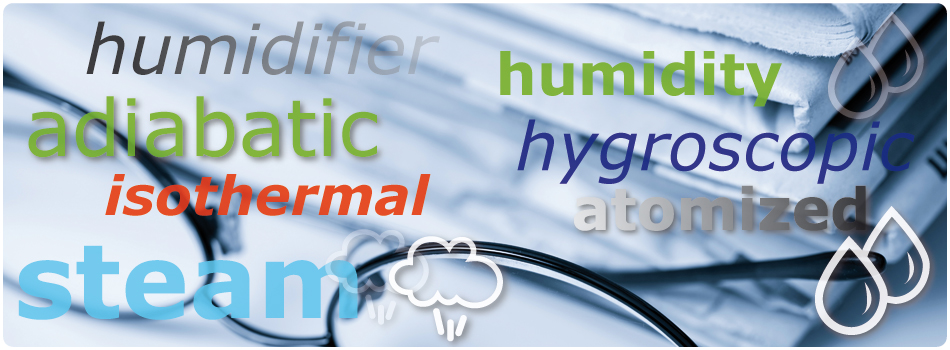Humidification important terms

Adiabatic (a. humidification process): air humidification by evaporation of water without adding energy from the outside
Atomize: break a liquid up into many very fine droplets so as to increase the contact surface with the air, thus assisting evaporation.
Compressed air and water atomizer: water atomization system that uses nozzles and compressed air
Condensation: change from the gaseous state of water (vapor) to the liquid state. Condensation occurs when hot and humid air is cooled, losing its capacity to hold water vapor.
Centralized steam distributor: air humidification system using a pressurized steam distribution network supplied by a central boiler
Static electricity: electrical charges that are generated by rubbing and friction
Hygroscopic: hygroscopic is the term given to materials whose cells absorb moisture, leading to a variation in their weight and dimensions. Hygroscopic materials always tend to reach equilibrium with the surrounding environment.
Isothermal: air humidification process without changes in temperature (dry bulb)
Dewpoint: temperature that the air must be cooled to, at constant pressure, in order to become saturated (i.e. 100% relative humidity). When continuing to cool the air condensation occurs.
Humidifier: product or system used to increase the specific humidity of the air
Immersed electrode humidifier: humidifier that, when applying voltage to metal electrodes immersed in common drinking water, heats the water (due to the Joule effect) until boiling, producing steam. The quantity of steam produced is proportional to the electric current, which is in turn proportional to the level of water.
Gas-fired humidifier: gas-fired humidifiers use a burner/heat exchanger system to produce steam.
Electric heater humidifier: immersed heater humidifiers heat the water until boiling by transferring heat from the hot element (electric heater) to the liquid. These appliances can operate on demineralized water, as they do not exploit the electrical conductivity of the water.
Ultrasound humidifier: humidifier in which a piezoelectric transducer, immersed in the water, converts the applied electricity into high-frequency mechanical vibrations. The water, due to its mass, is not able to keep up with this mechanical oscillation and thus creates successive waves of compression and depression, during which the water is split into very fine droplets.
Centrifugal humidifier: humidifier that uses a spinning disk to atomize the water and transform it into millions of very small droplets that are blown by a built-in fan into the room, where they evaporate, thus humidifying and cooling the air.
Humidity: water vapor contained in the air
Absolute humidity: quantity of water vapor expressed in grams contained in one cubic metre of air; depends on the air pressure.
Relative humidity: this is a humidity measurement representing the percentage of water contained in the air at a certain temperature (e.g.: 50% RH at 20 °C) in relation to the maximum amount of water vapor that the air can hold at the same temperature when saturated (100% RH).
Specific humidity: quantity of water vapor in grams contained in one kilo of air; this value remains constant, regardless of the pressure.
Water vapor: physical state of water, which can be defined as the aeriform state at a temperature lower than its own critical temperature.

